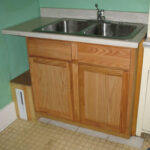Stainless-steel sinks have not been around forever. Back then, it was porcelain-coated cast iron. Although they were beautiful, heavy use would cause the porcelain to chip and then rust the iron underneath. Stainless steel was invented in 1913 by a gunsmith named Harry Brearly who worked for British Steel Corp. He experimented with creating stronger steel by adding chromium to the steel. While it added to the strength, he also noted it provided less corrosion because his gun barrels didn’t rust. It was later strengthened with nickel, which is very close to the modern day stainless steel we have in modern times.
Sinks are the most important part of any kitchen, especially a stainless-steel sink. They do tend to get grubby with age from physical wear and tear. But no matter how hard we try to keep them clean, they will age and they occasionally need to be replaced. It’s a fairly easy job; you just need a few tools and a little time.
The first thing you need is a cordless screw gun with a Phillips head bit. You want to remove the doors of the cabinet underneath the sink to provide enough room to work comfortably. Keep the screws together on the same hinge with a little tape. You do not want to mix them up because it might cause the doors to change swing slightly.
Next, you need to disconnect the water supply lines and the waste line. First, shut off the water supply valve. Most kitchen sinks have valves underneath to shut off the hot and cold. If you do not have these oval shaped valves under your sink, then find the shut off valve for your house. Next, turn on the faucet and let any water left in the line drain out. Turn the faucet off. Place a bucket underneath the sink before you disconnect and water or drain lines. Use an adjustable wrench to disconnect the water supply lines from the bottom of the faucet. Now, place the bucket under the drain trap and loosen the slip nuts off the drains tailpiece and back of the trap. Careful, don’t get any water on you or your cabinet!
Now you can remove the mounting clips. Underneath the sink, attached to the bottom side of the counter, you will notice there are several small metal clips with a Phillips head screw. Loosen those screws. The clips hold the sink firmly to the counter tops. Once the clips are removed and your pluming is free, carefully lift the sink up and out of the top of the countertop. You may need to gently persuade it from the bottom. Hold the sink upright until you get it outside, it may leak water out if you don’t! Scrape any old glue from the sinks edge with a plastic scraper. Do not use a razor blade; it may scratch your laminate countertop. Clean the entire surface with soap and water and remove any debris. You want a good clean surface when you install your new sink. Out with the old and in with the new!



